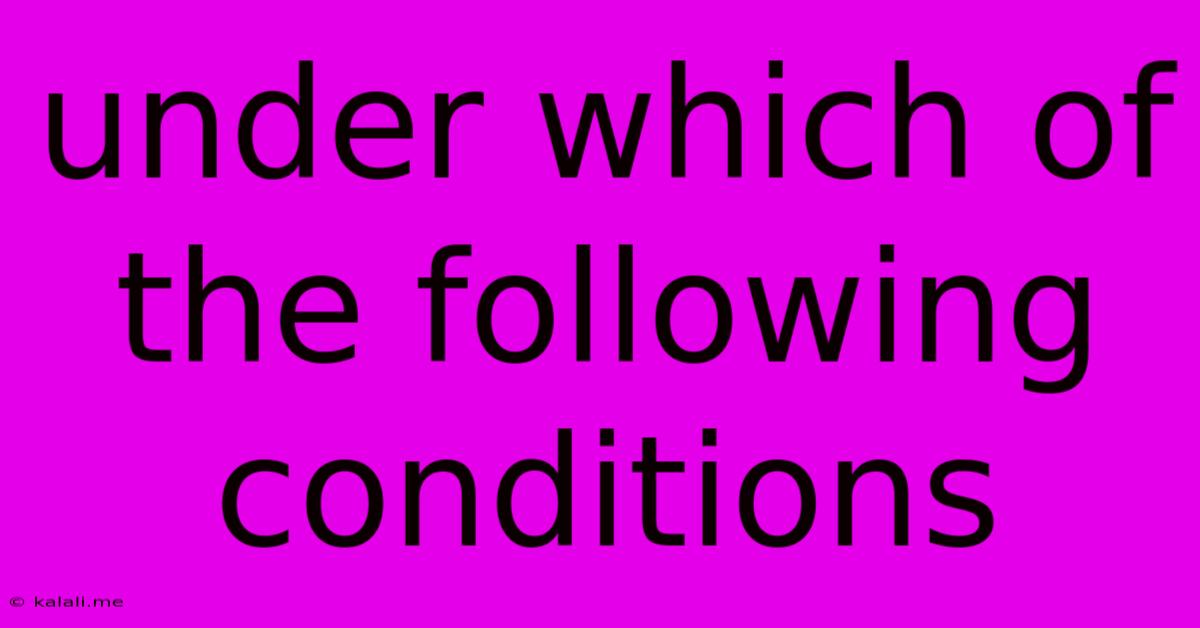Under Which Of The Following Conditions
Kalali
Jun 15, 2025 · 3 min read

Table of Contents
Under Which of the Following Conditions: A Comprehensive Guide to Conditional Statements
This article explores the concept of "under which of the following conditions," a phrase commonly found in multiple-choice questions, programming, and logical reasoning. We'll delve into how to approach such questions, examining the different types of conditions and providing practical examples to solidify your understanding. Mastering this skill will improve your problem-solving abilities across various disciplines.
What are Conditional Statements?
Conditional statements, at their core, are logical constructs that determine the execution of code or the validity of an argument based on whether a certain condition is true or false. They are essential for controlling the flow of a program or for analyzing a situation systematically. Think of them as a series of "if-then" statements. "Under which of the following conditions" essentially asks you to identify the specific circumstances that must be met for a particular outcome to occur.
Types of Conditions:
Several types of conditions can be encountered:
-
Simple Conditions: These involve a single comparison, such as "x > 5" (x is greater than 5), "y = 10" (y is equal to 10), or "z < 2" (z is less than 2).
-
Compound Conditions: These combine multiple simple conditions using logical operators like AND, OR, and NOT. For example: "x > 5 AND y < 10" (x is greater than 5 AND y is less than 10), or "a = b OR c = d" (a equals b OR c equals d). Understanding Boolean algebra is crucial here.
-
Nested Conditions: These involve embedding conditional statements within other conditional statements, creating a hierarchical structure. This allows for more complex decision-making processes. For example: "if (x > 5) { if (y < 10) { ... } }"
-
Conditions involving sets and ranges: These conditions may specify if a value is within a particular set or range. For instance: "x is an element of {1, 3, 5}" or "y is between 10 and 20 (inclusive)."
Approaching "Under Which of the Following Conditions" Questions:
When faced with a question phrased as "under which of the following conditions...", follow these steps:
-
Identify the Outcome: Clearly understand what outcome the question is referring to. What needs to happen for the condition to be met?
-
Analyze Each Condition: Examine each option individually. Determine whether it satisfies the requirements for the desired outcome. Pay close attention to the logical operators used (AND, OR, NOT).
-
Test with Examples: If possible, test each condition with a few examples. This can help visualize the condition's behavior and confirm your understanding.
-
Consider Edge Cases: Pay special attention to boundary conditions or exceptional cases. These are often overlooked but can be crucial for finding the correct answer.
-
Eliminate Incorrect Options: As you analyze each condition, eliminate any options that clearly do not meet the requirements.
-
Verify Your Choice: Once you have identified a potential answer, double-check your reasoning to ensure it's consistent and logically sound.
Examples:
Let's consider a simple example:
Question: Under which of the following conditions will the variable 'result' be equal to 10?
a) x = 5, y = 5, result = x + y b) x = 10, y = 0, result = x * y c) x = 20, y = -10, result = x + y d) x = 5, y = 5, result = x * y
Solution: Option (a) and (c) satisfy the condition because 5 + 5 = 10 and 20 + (-10) = 10. Option (b) results in 0, and option (d) results in 25. Therefore, options (a) and (c) are the correct answers.
Conclusion:
Understanding conditional statements and the phrase "under which of the following conditions" is vital for problem-solving in various contexts. By systematically analyzing each condition and considering edge cases, you can effectively tackle these types of questions and improve your overall logical reasoning skills. Remember to practice regularly to build your confidence and proficiency.
Latest Posts
Latest Posts
-
What Is 1 Watt Equivalent To
Jun 15, 2025
-
Compare And Contrast Prejudice And Discrimination
Jun 15, 2025
-
College Of The Desert Acceptance Rate
Jun 15, 2025
-
Atoms Combine In Simple Whole Number Ratios To Form Compounds
Jun 15, 2025
-
Which Of The Following Is Not A Symptom Of Alcoholism
Jun 15, 2025
Related Post
Thank you for visiting our website which covers about Under Which Of The Following Conditions . We hope the information provided has been useful to you. Feel free to contact us if you have any questions or need further assistance. See you next time and don't miss to bookmark.